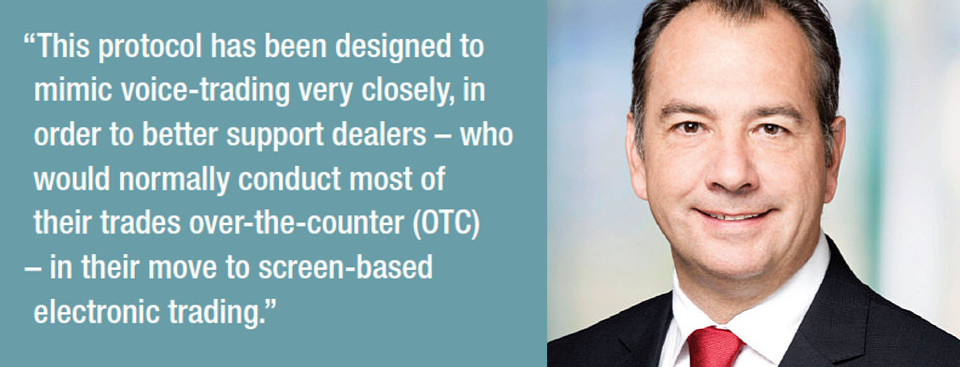Better interdealer execution generates natural liquidity
Banks’ reticence to trade with clients is a consequence of the cost of carrying risk; SIX Corporate Bonds de-risks interdealer trading and liberates dealer-to-client business as Frédéric Messein, Head of SIX Corporate Bonds and Member of the Management Committee, SIX Swiss Exchange explains.
Liquidity has become more expensive in the corporate bond market. We see interdealer brokers reaching out to the buy side to support their falling volumes. Buy-side firms are trading client-to-client to source liquidity. However, these are symptoms of the fundamental problem; dealers are trading with each other in lower volumes due to the balance sheet cost of carrying risk.

SIX has delivered a solution, SIX Corporate Bonds, that makes interdealer transactions work economically and securely for block trades, sized at 2 million+ in a major currency, traded in lots of 1 million.
It has created a marketplace for corporate and financial bonds, investment grade and high yield, in US dollar, Euros and Sterling with a minimum issue size of 250 million. That covers initially around 5,000 bonds, in which dealers can now move risk simply, securely and economically in order to respond to customer requirements. Any bank can find the other side to a client’s trade more easily, in effect creating a virtual balance sheet to support risk trades.
A better model for dealers
At the heart of SIX’s model is the greater facilitation of dealer-to-client trading through efficient risk transfer on the dealer-to-dealer market. Understanding that the conundrum sits on the sell side, SIX Swiss Exchange has sought to increase the ability of dealers to exchange risk.
It has achieved this by using smart systems to overcome existing barriers to interdealer trading, without forcing the market into a ‘new way’ of trading. The platform functions as a dealer-to-dealer dark pool to support an anonymous engagement to find the other side of a client’s trade. Without pre-trade disclosure, the model minimises information leakage. A well proven trading workflow, designed by heads of trading at major dealers, which is an indication-of-interest (IOI) session-based protocol has been employed to support price formation negotiation and work-ups on an anonymised basis.
This protocol has been designed to mimic voice-trading very closely, in order to better support dealers – who would normally conduct most of their trades over-the-counter (OTC) – in their move to screen-based electronic trading. The purpose is to be evolutionary, not revolutionary, in its migration of business, allowing dealers to introduce velocity to their inventories.
Asset managers can make prices at the point they are prepared to trade an existing portfolio manager’s order, however, providing instant liquidity by way of providing two-way risk pricing on demand is unlikely to ever be within their remit. Consequently, for all of the advantages that all‑to‑all trading offers, it does not replace accessing the dealer’s balance sheet.
The clients of dealers engaging with SIX Corporate Bonds will see a marked improvement in their dealers’ capacity to trade risk, improving liquidity using their existing relationships.
SIX Corporate Bonds enables an agency-trading approach, using algorithmic technology to provide the functionality to look for bonds based upon their characteristics in addition to specific ISINs, or for example the name of the issuer or duration.
A familiar workflow, improved
The workflow is designed to facilitate secure trading to prevent gaming, but uses industry standard practices and workflow to ensure ease of use. Banks can upload IOIs/Axes and lists of ISINs automatically from their ION Risk System, or their pricing engines, or from their Synchronicity Engine. An IOI can only be raised for any given ISIN on one side, it is not possible to upload two-sided IOIs on the same ISIN.
To help manage the episodic nature of fixed income order flow, the system operates continuously, constantly looking for matches during the day. This removes the challenges that using regular weekly auctions creates around timing.
When a bank has entered an IOI, the level at which it wishes to trade at remains hidden from the market, but is used as guidance by the system. Only potential counterparts who have set their own level close enough can get sent match information to form a price for negotiation. Ranges are set in basis points according to the credit quality of the instrument (investment grade bonds are traded in spread, high yield bonds are traded in price).
The trader will then see one of four possible results:
- No notification at all will indicate there is nobody on the other side.
- A ‘live’ notification indicates there is at least one other potential counterpart on the other side of that ISIN, without any information on how many;
- A ‘historic match’, indicates that the system has identified a potential counterpart who has traded that ISIN in the recent past.
- The fourth notification, is ‘both’ where there are market participants with live IOIs as well as historical engagements.
Engaging and executing
The first mover, buyer or seller, then determines how to engage, either choosing an immediate market session or ‘Curtain Time’.
An immediate market session supports a trader whose priority is time. The session lasts three minutes; and as soon as they have found the counterpart to negotiate with during that three minute window, both are moved to a market session.
Curtain Time is an auction lasting 30 minutes, where the counterpart is the best of the other sides. This works best for a firm looking for the best opportunity, with less time pressure. The initiator can wait for their counterparties to input or firm up their IOI, then the system will take the best initial price response. They must wait for the end of the 30-minute window to know what is on the other side.
Once in market session, the two sides are in negotiation until they reach an agreement. A feature in this session called ‘meet at mid’ can be used; if one of the traders uses it there is no notification to the other side, but if both press ‘meet at mid’ during the session, it crosses at mid automatically, helping to speed up the process of incrementally improving a price.
The protocol works on a name-give-up basis, so only at the end of a session in which a trade is printed do the traders get to know who the other side is. As a result a bank can trade part of its position and once the trade is completed, add more if they are comfortable working with that counterparty.
The ‘Broker work-up’ phase is then engaged to allow those counterparties to add volume at the price already agreed. The final phase is the ‘public work-up’, that allows those who were not fast enough initially or were are not good enough on the price but had an IOI for that particular security to add volume at the price already negotiated. The new counterparties will not know who have already traded when they get invited, only what traded and the price at which it traded.
To minimise the risk of gaming even further, whenever a participant changes their price the negotiation window is extended by 30 seconds. Equally any quote firmed up is held for 10 seconds to prevent firms from putting on a price and then pulling it out after they have seen the other side.
The machine: Lower costs and higher efficiency
SIX Corporate Bonds uses software which is held and managed on the SIX Swiss Exchange market infrastructure. This well-oiled machine charges for the service it delivers, at 1 cent a side, with a 25% discount for the two firms that form the price (0.75 cent fee a side).
This undercuts the existing model where a firm must pay more according to longer maturity, higher yield and risk profile, which can reach 5 to 6 cents a side for high yield bonds.
SIX Corporate Bonds offers e-connectivity, secure, low cost trading and prevents disintermediation of the sell side.
It provides a clean route to increasing liquidity for the sell side, and by proxy their buy-side clients, overcoming the reduction in balance sheet they have faced, moving them forwards into a more liquid market.

www.six-group.com
©Markets Media Europe 2025










